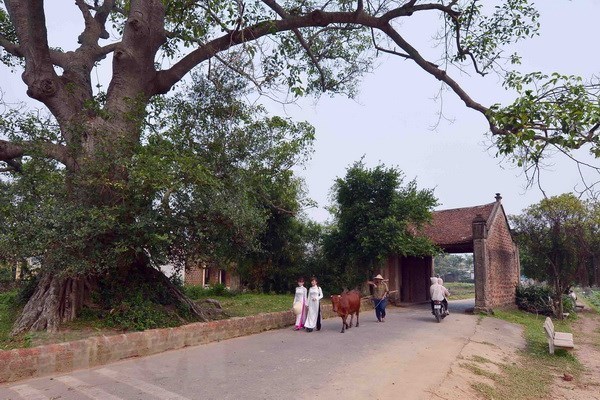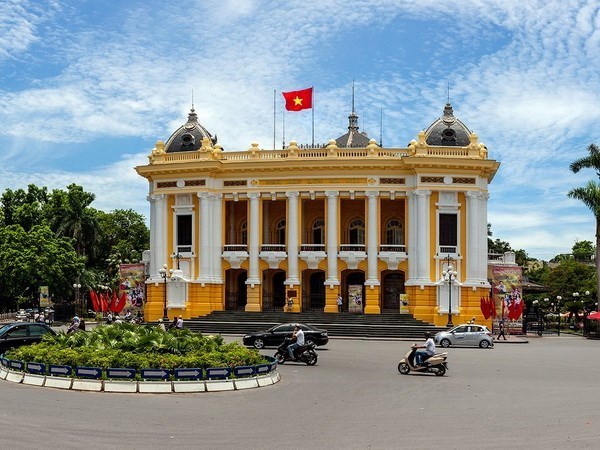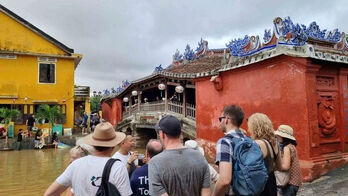
The gate to Duong Lam ancient village, a popular tourist destination in the suburbs of Hanoi. (Photo: VNA)
The lingering fourth wave of the COVID-19 pandemic has made it compulsory for the imposition of movement restrictions to contain the coronavirus transmission, which has greatly affected people’s spiritual life.
Given this, as soon as Hanoi lifted social distancing rules and eased curbs on socio-economic activities in late September, travel demand has risen sharply. While tourism activities nationwide have yet to fully recover, on-site travel is becoming a major trend and proving to be an effective solution.
Except for museums and parks, other tourist sites in Hanoi haven’t been reopened. While people are still reluctant to visit those places of interest, many have chosen to spend their weekends at resorts and homestay facilities in the suburbs of the capital city.
This trend is attributable to the fact that after months of arduous staying at home due to the coronavirus resurgence, people are in great need of relaxation in an open space, fresh air, and close to nature. It is also suitable to the current context, when it is unable to put the pandemic under a complete control, as travellers can have their own space, thus helping reduce contact among different tourist groups.
Nguyen Van Quan, Managing Director of the Tan Da Spa Resort in Van Hoa commune of Ba Vi district, said right after Hanoi halted social distancing and hotels and other accommodation facilities were permitted to operate at their 50-percent capacity, the number of people booking rooms at resort and homestay sites in the suburbs has begun to bounce back.
Going on holiday after the social distancing period is now a choice of many Hanoians, he went on, noting that resorts and homestay sites along Thang Long Avenue which are in close proximity to the downtown are currently a magnet to tourists.
Quang added the Tan Da Spa Resort is always half full in every weekend, and that the site only serves fully vaccinated visitors coming from “green zones” so as to ensure pandemic safety.
A manager of The Moonlight, a homestay establishment in Minh Phu commune of Soc Son district, said the district is home to hundreds of homestay facilities, most of which are fully booked on weekends, and it is also the case for The Moonlight.
A large number of people have also chosen similar sites in the outlying districts of Ba Vi, Son Tay, Thach That, and Dong Anh as their leisure destinations.

Hanoi Opera House, a tourist magnet in the capital city. (Photo: VNA)
Tourism authorities, associations, clubs, and companies in Hanoi are promoting the building of safety tours, with priority given to local places to serve residents in the capital city.
On October 23, the Hanoitourist travel company launched a walking tour enabling visitors to explore the unique historical and architectural values of structures built in the French time, including the Vietnam National Museum of History, Hanoi Opera House, and Bac Bo Phu (now the Government Guest House), in the city.
Hanoitourist Director Phung Quang Thang said tour prices have been discounted strongly to stimulate local travel demand, adding that more tours in the new normal will be developed by his company.
Many other travel businesses are also eager to launch tours of places of interest in the capital to attract Hanoians.
Authorities are planning to recover tourism in four phases, firstly focusing on local visitors. The city will reopen several “green” (free of COVID-19) tourist sites that have qualified infrastructure and unique tourism products on a trial basis, encourage sports, leisure, and homestay tourism in Ba Vi, Son Tay, and Soc Son; and permit travel companies to open short caravan tours in “green” places.
After that, Hanoi will coordinate with some localities that have brought the pandemic under control to resume inter-provincial travel.
The return to the new normal is giving much hope to the tourism sector to meet people’s travel demand and shore up the pandemic-hit industry./.
VNA
 Vietnam sees record foreign tourist arrivals despite stormy season
Vietnam sees record foreign tourist arrivals despite stormy season




